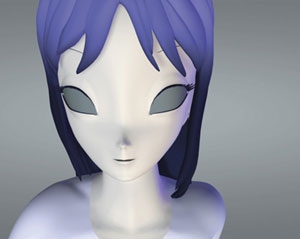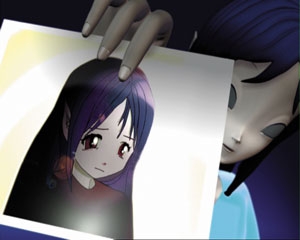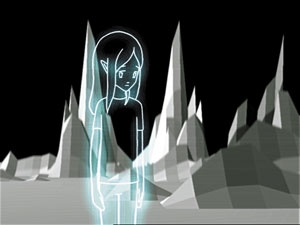Feature: Reviews
No Ghost Just a Shell
- San Francisco Museum of Modern Art
- December 14, 2002 — March 16, 2003
“True heroes are rare and extremely expensive . . .”
— Philippe Parreno
Requiem for a Mail Order Bride
Trust the French to turn a playful jeux into a complex semiotic/legal/existential/moral/cultural conundrum by enlisting — purchasing, actually — a female tabula rasa. In No Ghost Just a Shell (the title refers to Mamoru Oshii’s 1995 Japanese animated film Ghost in a Shell, based on the original manga by Masamune Shirow), the blank slate is a bland, commercially produced cartoon drawing of a wide-eyed, elf-eared, prepubescent girl whose only distinguishing characteristic is her undeveloped potential.
In 1999, the French artists Pierre Huyghe and Philippe Parreno found her image in the catalogue of Kworks, a Japanese agency that develops manga figures for animated films, comic strips, advertising, and video games. The prices of these images depend on the complexity of their character traits. The copyright for this one — a nondescript, expendable, empty vessel ripe for exploitation — was cheap: a mere $428 for her digital file.
Parreno and Huyghe bought this cipher, named her Annlee (aka AnnLee, or Ann Lee), gave her a cosmetic makeover, and, with Anna-Lena Vaney, set up a state-of-the-art video animation facility for her in Paris. They started filling her in, so to speak, and — expanding the French Surrealist tradition of the “exquisite corpse” — they lent her free of charge to other artists they commissioned to do likewise.
Since Annlee’s life expectancy had been short to begin with, the artists were arguably doing her a favor. Thanks to her new handlers she acquired an identity, multiple identities, in fact, and a voice, several voices. She achieved something approaching self-consciousness. Her existence was prolonged; she’d have experiences her original creators had never dreamed of for her. With so many artists animating her, investing her with various virtual inner and outer lives and a wardrobe of personalities, she’d gained quasi-celebrity status, maybe even a kind of immortality.
In its three years of operation, the Annlee industry produced animated videos by Huyghe and Parreno as well as Liam Gillick, Dominique Gonzales-Foerster, Francois Curlet, Melik Ohanian, and Rirkrit Tiravanija. Other artists and writers who participated in the project include Joe Scanlan, Douglas Gordon, Sylvie Fleury, Molly Nesbitt, Catryn Davis, Angela Bulloch and the actress Catherine Deneuve. (A catalogue documents all the work.)
Following this flurry of intense artistic activity, Huyghe and Parreno pulled the plug on Annlee. She’d been through enough; no other artists, or anyone else — especially the entertainment industry via television products, video games, advertising, press, and publishing — would be allowed to exploit her image ever again for any purpose. They would give Annlee back to herself.
The legal document which transfers Annlee’s copyright to a foundation that belongs solely to her is, in effect, her death warrant. Paradoxically, it also gives her her freedom since “The acquisition of ANNLEE is part of an artistic project that consists in liberating a fictional character from the realm of representation.” “Give me liberty and give me death” could be her epitaph.
An Annlee extravaganza, showing all the works associated with the Annlee figure, was presented at the Kunsthalle Zurich in Switzerland last Fall. In December 2002, Huyghe and Parreno staged her apotheosis at the Miami Basel Art Fair, where Annlee literally went out in a blaze of glory: a firework display emblazoning her waiflike melancholy face across the night sky.
The spare, elegiac exhibition currently at SFMOMA organized by Benjamin Weil, the museum’s curator of new media, is designed as a mournful mock farewell: In Memoriam Annlee. The temperature in the three galleries is icy, frigid as a morgue. In the first, Joe Scanlan has placed a DIY funeral parlor: a closed white casket flanked by low stands (all from IKEA) bearing bouquets of daisies. A copy of the legal document assigning Annlee’s rights to herself is on the wall. Subdued organ music in the background would have been a nice touch. When I was there, two young women in the gallery were practicing a basic tap dance step. Maybe they were just trying to stay warm.
Gallery 2 contains only a neon wall portrait of Annlee, Skin of Light, designed by Catherine Deneuve and executed by Huyghe and Parreno: an object neatly combining the iconographies of fame and martyrdom using Annlee’s image. Her face is in lights, yet it remains vapid and pathetic.
Gallery 3 has a lithographed poster for the show on one wall, and a TV monitor, perched on the packing crate it came in, showing seven animated videos that feature Annlee. I found this section frustrating. The videos themselves (Gillick’s apart, which is inventive, fast-moving and visually compelling) are static and not very interesting to look at on such a restricted scale, and the sound quality in the room is abysmal, so most of the monologues are incomprehensible. The videos were meant and deserve to be seen as large-scale projections in sound-insulated rooms, as were the two I saw a year ago at P.S. 1 in New York, and as they were all exhibited in Zurich and are now being shown at the Center of Visual Culture in Cambridge, England.
This option was apparently not available at SFMOMA, and the works suffer as a result. In Huyghe’s One Hundred Million Kingdoms (2001), for instance, the ghostly outline of Annlee walks through a moonscape whose distant mountain ranges are continuously made and unmade, graphing the sound waves produced by her monologue, which combines fragments of Neil Armstrong’s moonwalk observations with passages from Jules Verne’s Journey to the Center of the Earth. In this, as in the other videos, the text and its delivery are integral to the animated imagery. They should be larger than life so as to overwhelm the viewer with their central paradox: that is, the spectacle of so much human artistry, technology, effort and intelligence expended to give to airy nothing a local habitation and a name.
Despite its restricted compass here, No Ghost Just a Shell is a memorable and thought-provoking project. It raises disturbing and intriguing questions about the nature of representation, the ownership of imagery, and the processes of image production, distribution and audience reception. It addresses notions of authorship, authenticity, fiction, and reality, and the role of the artist.
Annlee’s ambiguous status as a girl without qualities invites the viewer to project his/her own fantasies on her, yet she resists those projections by virtue of her utter lack of any captivating traits. No matter what they do to Annlee, she will never be real. Still, her vacuous image haunts you. You think of colonialism… of the co-option and exploitation of women and their images for commercial purposes… of the ephemeral, manufactured nature of fame… of the synthetic personae created for real women by the entertainment industry and what it does to their lives (Garbo, Marilyn, J.Lo…) You know her memory will live on in the discourse inspired by her for years to come. And you wonder if Annlee will become a cult figure whose legally protected image and persona will be pirated by who knows whom and for what purposes, now that she’s gone?



